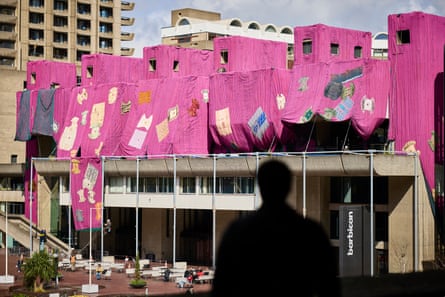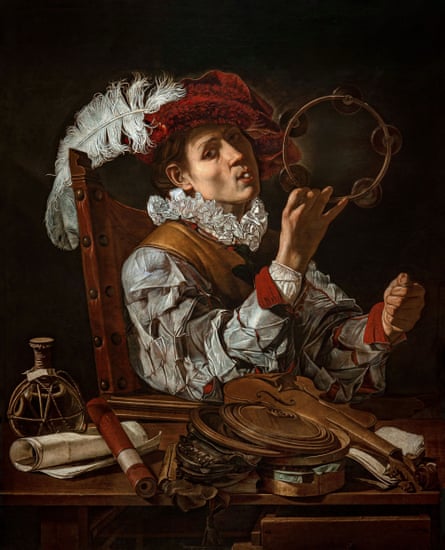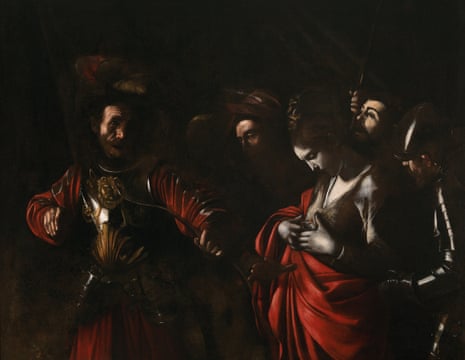Exhibition of the week
The Last Caravaggio
The despair and darkness of Caravaggio’s The Martyrdom of Saint Ursula will hold you transfixed.
National Gallery, London, 18 April-21 July
Also showing
Yinka Shonibare
A great show by this endlessly fertile and thought-provoking master of global pop art.
Serpentine Gallery, London, until 1 September
The Goddess, the Deity and the Cyborg
The paintings of Monica Sjöö and photomontages of Mary Beth Edelson embody the beliefs of goddess feminism.
Murray Edwards College, Cambridge, until 8 September
Georg Baselitz
This unrepentant artist of nudes is still confessing what he calls his “sins” and painting brilliantly at 86.
White Cube Bermondsey, London, until 16 June
London Pictures
Gilbert & George celebrate their beloved city in all its ugliness, violence and excitement.
The Gilbert & George Centre, London, until end of 2024
Image of the week

Ibrahim Mahama’s work Purple Hibiscus drapes London’s Barbican arts centre in 2,000 sq metres of bright fabric, dotted with embroidered robes, as part of the Barbican Art Gallery’s current textiles show. Much of it was handmade in a football stadium in the artist’s base in Tamale, Ghana. When the show closes, the gloriously colourful cloth will go back to Ghana to be reused in future works. We interviewed Mahama as he oversaw the installation.
What we learned
Yinka Shonibare’s five-star show brought colonial figures down to size
American artists united to urge voters to defend democracy
Jason Wilsher-Mills turned childhood paralysis into compelling giant comic-strip sculptures
John Akomfrah’s Venice Biennale thoughts ranged from Chinese poetry to the Rwanda fiasco
A Munich gallery worker was sacked for hanging his own art with Warhol’s
A designer faced death threats in Portugal for simplifying the government’s logo
Compton Verney marked its 20th anniversary with a fabulous triple bill
Simon Phipps went to Wales in search of brutalism
A Japanese photographer captured Northern Ireland’s Troubles as never before
Masterpiece of the week
A Musician (Conjurer) by Cecco del Caravaggio, c.1610

There is quite a story behind this painting. Cecco del Caravaggio started out as a servant and pupil of Caravaggio. He was also his master’s model. As an adolescent he appears as Isaac, howling as his father holds a knife to his throat in Caravaggio’s Sacrifice of Isaac; as the nude John the Baptist; and wearing black stage-prop wings in Caravaggio’s most perturbing work, Victorious Cupid. When a 17th-century English visitor to Rome saw Victorious Cupid he was told it portrayed Caravaggio’s “boy, that laid with him”. Caravaggio gave Cecco a decent education in painting, as A Musician (Conjurer) proves. It’s a very accomplished portrayal of every day life in the “Caravaggesque” style that swept Europe in the 1600s. That’s not the end of the story. When the Duke of Wellington helped free Spain from Napoleon he was rewarded with a huge haul of art including this canvas. Today it hangs in Wellington’s home Apsley House, Number One Hyde Park. From Caravaggio’s bed to the Battle of Waterloo to one of London’s premier addresses, this painting tells a hell of a tale.
Apsley House, London
Don’t forget
To follow us on X (Twitter): @GdnArtandDesign.
Sign up to the Art Weekly newsletter
If you don’t already receive our regular roundup of art and design news via email, please sign up here.
Get in Touch
If you have any questions or comments about any of our newsletters please email newsletters@theguardian.com
